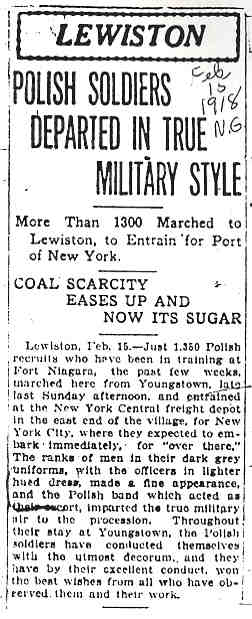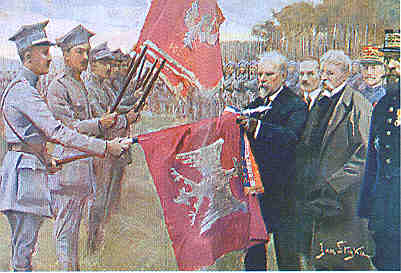| The Officers Club |
| |
| at Fort Niagara State Park |
| The Polish Blue Army and Fort Niagara State Park |
The land now occupied by Fort Niagara State Park has a special significance for Polish Americans. This was the site where, during World War I, a contingent of American Polish Army volunteers from all over the United States trained prior to sailing for Europe. There they fought, first in France, later in Poland, in a successful effort to regain Poland's independence and safeguard the territorial integrity of the resurgent nation.
|
|
World War I begun as a conflict between Germany and Austria, on one hand, and Russia, on the other. These were the three imperial powers that had partitioned Poland and deprived it of its independence for over 100 years. Poles, the world over, perceived that, as these three militarily potent empires exhausted each other and fought to a standstill, a historic opportunity might arise for Poland to regain its independence. To take advantage of that opportunity, the Poles would need an army. The turned to France, which was also at war with Germany. The French agreed to both the formation and equipping of a Polish Army that would fight the Germans alongside the Western Allies - France and Britain - on Western Front.
In the United States there were, as the time, some three million immigrants from the Polish lands. Many volunteered to serve in this Polish Army. Prior to the entry of the United States into World War I on the side of the Western Allies, these men trained at Niagara-on-the-Lake, across the river from Fort Niagara, in what was then Britain's Canadian Dominion. After the American declaration of War in April 1917, units of the Polish Army, equipped in the bluish French uniforms trained also at Fort Niagara, and departed hence for the War in Europe, as evidenced by the old clipping from the Niagara Gazette of February 15, 1918. In France, they joined other Polish Army units and fought , under the command of General Jozef Haller, at side of Allies on the Western Front.
Following the armistice of November 11, 1918, the well equipped, 100,000 men Army was transported across Germany to the newly resurgent Polish nation and there helped secure the country's frontiers, taking part in the defense of Poland against the 1920 Bolshevik invasion.
Eventually, in 1923, American Polish Army volunteers repatriated to the United States, forming here Polish Army Veterans Posts which still exist today. Much time has elapsed and it is questionable whether any of the original Polish Army volunteers are still alive today. However, after the German invasion of Poland in 1939, Polish Army units were again formed from Poles outside of Poland and fought at the sides of the Allies throughout World War II.
At the end of the war, Poland was consigned to the Soviet sphere of influence. The majority of these Polish veterans decided not to return to the less than free Poland which was quickly being transformed into a Soviet sattellite. Instead, many emigrated to the United States where they were welcomed by the World War I veterans of the Polish Army. They joined the Polish Army Veterans Posts originally founded by the World War I veterans of the Polish Blue Army. All of the World War I veterans having passed away, these World War II veterans now form the membership of the Polish Army Veterans Posts. As a tribute to the valiant men who, at the risk of their lives, that helped Poland achieve its independence in 1918, the current veterans participate in Veterans and other ceremonies wearing the uniforms of the Polish Blue Army.
|
|
| OFFICERS CLUB SITE MAP |
| FORT NIAGARA STATE PARK | OLD FORT NIAGARA |
| Info-Poland a clearinghouse of information about Poland, Polish Universities, Polish Studies, etc. |

